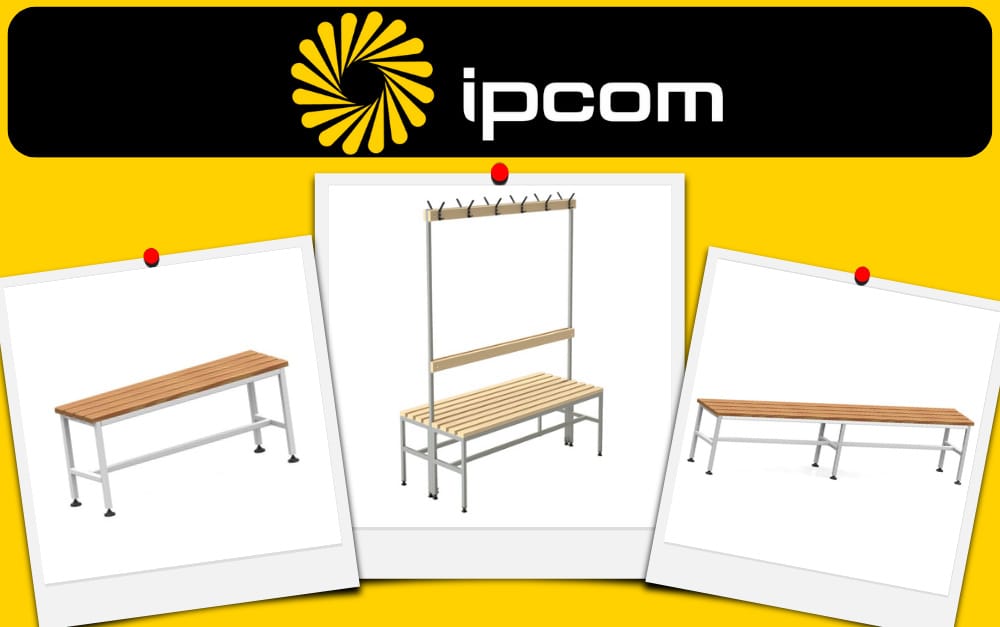Looking for the perfect changing room bench but overwhelmed by all the options? Wooden, metal, plastic, or cushioned — each material has its own advantages. Benches come with hooks, with a backrest, without a backrest, with a shoe shelf, or with a small locker. Which one should you choose? In this article, we will expertly review the different types of benches for your changing room. We will also compare their pros and cons and help you pick the best option for your facility.
Choosing Your Changing Room Bench Material
Today, manufacturers offer a wide range of materials for indoor benches. Let’s explore their strengths and weaknesses in detail.
- Wooden benches – warm to the touch, visually appealing, eco-friendly. However, wooden legs may wear out over time, especially under heavy use and high loads on the bench. They can crack, deform, or become loose. In humid environments, they may also absorb moisture if not properly treated and coated. They are suitable for use in school and kindergarten changing rooms.
- Wood bench with metal legs – combines the warmth and visual appeal of wood with the strength and durability of a metal frame. This design can withstand heavy loads and offers comfort while sitting. If the steel is coated with anti-corrosion protection and the wood is properly treated to resist moisture, you will find very few drawbacks. One of them is the weight – these models are heavier than wooden or plastic ones, making them harder to move. They are ideal for gyms, sports halls, school locker rooms, and workplace changing rooms.
- Plastic models – one of the most popular types of benches for wet environments such as pools and saunas. They are lightweight, water-resistant, and easy to clean. Plastic benches are durable under regular use but may bend under very heavy loads.
- Upholstered benches – comfortable, soft, and stylish. They provide a premium seating experience, but wear out faster than other types. The upholstery can rub, crack, or tear over time. They are suitable for most changing rooms, provided there is a budget to replace them regularly.
Consider the strengths and weaknesses of the different kinds of benches carefully before making your choice.
Types of Indoor Benches: Configurations
- Benches with coat hooks – include built-in hooks for hanging clothes, bags, or towels.
- Seating with lockers – integrate seating with small storage compartments for personal items.
- Double-sided benches – seating available on both sides, maximizing space in narrow changing rooms or hallways.
- Freestanding backless models – simple, lightweight design; easy to move and fit in small spaces.
- Benches with shoe rack – include a lower shelf to organize shoes.
- Wall-mounted models – fixed to the wall to save floor space.
Which types of benches should you choose?
To find the right model among different types of benches, you need to know the room’s size and layout, its style, as well as the intended amount of equipment.
- For narrow spaces, choose single-sided or wall-mounted models. They save space and allow easy passage
- For large or busy changing rooms, double-sided benches or benches with built-in lockers are ideal. They efficiently combine seating and storage.
Where to buy benches wholesale
Discover the perfect combination of style and durability with IPCOM-Group. Engineered from premium wood and sturdy stainless steel frames, our benches are built to last. Enjoy:
- Precision workmanship
- Competitive wholesale prices
- Fast international delivery
- The ability to manufacture any type of bench
If you are looking for benches wholesale or custom-made, IPCOM-Group is ready to serve you!



 info@ipcom-group.pl
info@ipcom-group.pl +48-57-35-69-079
+48-57-35-69-079
